5 VBA Basics
Visual Basic for Applications (VBA) is a programming language that allows you to automate tasks in Microsoft Office applications, such as Excel, Word, and PowerPoint. VBA is a powerful tool that can help you save time and increase productivity by automating repetitive tasks, creating custom functions, and building user interfaces.
In this chapter, we will cover the basics of VBA programming, including how to write your first VBA program, use comments, and print output to the Immediate Window and message boxes.
5.1 How Programming Languages Work
Programming languages are used to write instructions that tell a computer what to do. These instructions are written in a specific syntax that the computer can understand and execute. When you write code in a programming language, you are essentially giving the computer a set of commands to follow.
Programming languages can be classified based on several criteria, including their level of abstraction, how they are executed, and how they handle data types. In the following, we will discuss some of the key characteristics of programming languages and how they apply to VBA.
High-Level vs. Low-Level Languages
Programming languages can be classified into two main categories based on their level of abstraction and complexity:
- High-Level Languages: These languages are closer to human language and are easier to read and write. Examples include Python, Java, and VBA. These languages are designed to be user-friendly and abstract away the complexities of the underlying hardware.
- Low-Level Languages: These languages are closer to machine language and are more difficult to read and write. Examples include Assembly language and machine code. These languages are designed to interact directly with the hardware and are used for system-level programming. Their syntax is more complex and requires a deeper understanding of computer architecture.
Therefore, VBA is a high-level language, allowing users to write code in a more human-readable format.
Interpreted vs. Compiled Languages
Programming languages can also be classified based on how they are executed by the computer:
- Interpreted Languages: In interpreted languages, the code is executed line by line by an interpreter. The interpreter reads the code, translates it into machine code, and executes it immediately. Examples include Python, JavaScript, and Ruby.
- Compiled Languages: In compiled languages, the code is translated into machine code by a compiler before execution. The compiler reads the entire code, checks for errors, and generates an executable file that can be run independently of the source code. Examples include C, C++, and Java.
- Hybrid Languages: Some languages, such as VBA, are a combination of interpreted and compiled. When you write VBA code in Excel, the code is stored in the workbook file. When you run the code, Excel compiles the code into an intermediate language called P-code (pseudo-code) and stores it in the workbook. The P-code is then interpreted and executed by the VBA interpreter.
Therefore, VBA is a half-compiled and half-interpreted language.
A compiler is a program that translates source code written in a high-level programming language (such as VBA) into machine code that can be executed by the computer. The compiler checks the syntax of the code and generates an executable program if there are no errors.
Strongly Typed vs. Weakly Typed Languages
Programming languages can also be classified based on how they handle data types:
- Strongly Typed Languages: In strongly typed languages, variables must be declared with a specific data type, and the type of a variable cannot change during execution. This helps prevent errors and ensures that variables are used correctly. Examples include Java, C++, and VBA.
- Weakly Typed Languages: In weakly typed languages, variables do not need to be declared with a specific data type, and the type of a variable can change during execution. This can lead to errors if variables are used incorrectly. Examples include JavaScript, PHP, and Python.
VBA supports both strong typing and weak typing, depending on how you declare variables. You can enforce strong typing by explicitly declaring the data type of variables, or you can use implicit typing to allow variables to change type dynamically.
Static vs. Dynamic Typing
Programming languages can also be classified based on how they handle data types at compile time and runtime:
- Static Typing: In statically typed languages, the data type of variables is checked at compile time. This helps catch errors early and ensures that variables are used correctly. Examples include Java, C++, and C#.
- Dynamic Typing: In dynamically typed languages, the data type of variables is checked at runtime. This allows for more flexibility but can lead to errors if variables are used incorrectly. Examples include Python, JavaScript, and Ruby.
VBA is a statically typed language, meaning that the data type of variables is checked at compile time. This helps prevent errors and ensures that variables are used correctly in your code.
A variable is a named storage location in memory that holds a value. Variables are used to store data that can be manipulated and changed during program execution. Variables have a name, a data type, and a value. By using variables, you can store and work with different types of data in your programs.
You can think of a variable as a container that holds a value. It is a bin or a box that you can put things in and take things out of. For example, you can create a variable called counter to store a number, or a variable called message to store text. Variables are an essential concept in programming and are used to store and manipulate data in your code.
A data type is a classification that specifies which type of value a variable can hold. Data types define the size, range, and operations that can be performed on the variable. For example, an integer data type can hold whole numbers, while a string data type can hold text. Data types help ensure that variables are used correctly and efficiently in a program.
5.2 Why Learn VBA?
Learning VBA can provide several benefits, including:
- Accessibility: VBA is integrated with Microsoft Office applications, making it easy to use and learn for users familiar with Excel, Word, and PowerPoint.
- Automation: VBA allows you to automate repetitive tasks in Excel, Word, and PowerPoint, saving you time and increasing productivity. With Macro recording, you can record and play back actions to automate tasks.
- Customization: VBA enables you to create custom functions and procedures that extend the functionality of Microsoft Office applications.
- Integration: VBA can be used to integrate data and processes across different Office applications, allowing you to work more efficiently.
- User Interfaces: VBA allows you to create custom user interfaces, forms, and dialog boxes that enhance the user experience in Office applications.
- Data Analysis: VBA can be used to perform complex data analysis, manipulate data, and generate reports in Excel.
5.3 Editing VBA Code
Visual Basic for Applications (VBA) code is written in the Visual Basic Editor (VBE) within Microsoft Office applications. VBE is an integrated development environment (IDE), a software application that provides comprehensive facilities to computer programmers for software development. IDEs typically include a source code editor, build automation tools, and a debugger.
We are going to enable the editor in Excel, but VBA can be used in conjunction with any Microsoft Office application. Follow the steps below to enable the editor.
While the Visual Basic Editor (VBE) is the primary editor for VBA code, you can also use other editors to write and edit VBA code. For example, you can extend the capabilities of the VBE with third-party tools like Rubberduck, which provides additional features for VBA development, such as code inspections, refactorings, and unit testing. If you want increase your productivity and enhance your VBA development experience, consider exploring these tools.
Step 1. Install Microsoft Excel
The Microsoft Office 365 is available for UT students; you can access (via Cloud) and/or install:
- Word
- Excel
- PowerPoint
- Teams
- Outlook
- OneDrive
Learn more about obtaining MS Office 365 (Excel) at: https://www.utwente.nl/en/lisa/faq/office365-faq/.
Step 2. Enable the Developer Tab
To code in VBA, you have to enable the Developer tab in Excel to access the Visual Basic Editor (VBE). Follow these steps to enable the Developer tab:
- On the File tab of Excel, choose Options to open the Options dialog box.
- Choose Customize Ribbon on the left side of the dialog box.
- Under Choose commands from on the left side of the dialog box, select Popular Commands.
- Under Customize the Ribbon on the right side of the dialog box, select Main Tabs in the drop-down list box, and then select the Developer checkbox.
- Choose OK.
5.4 First VBA Program
In the following example, we will write a simple VBA program that displays a message box with the text “Hello, World!” when executed.
Steps:
Open the VBA editor in Excel.
- Way 1: Press
Alt + F11. - Way 2: Go to
Developer>Visual Basic(make sure theDevelopertab is visible in the ribbon).
- Way 1: Press
Insert a new module.
- Right-click on the
VBAProject(e.g.,VBAProject (Book1)) in the Project Explorer window. - Select
Insert>Module. - A new module will be added to the project.
- Right-click on the
Write the following code:
Position the cursor inside the
HelloWorldsubroutine.Press
F5to run the program or click theRunbutton in the toolbar.Save your workbook as a macro-enabled workbook (
.xlsm).
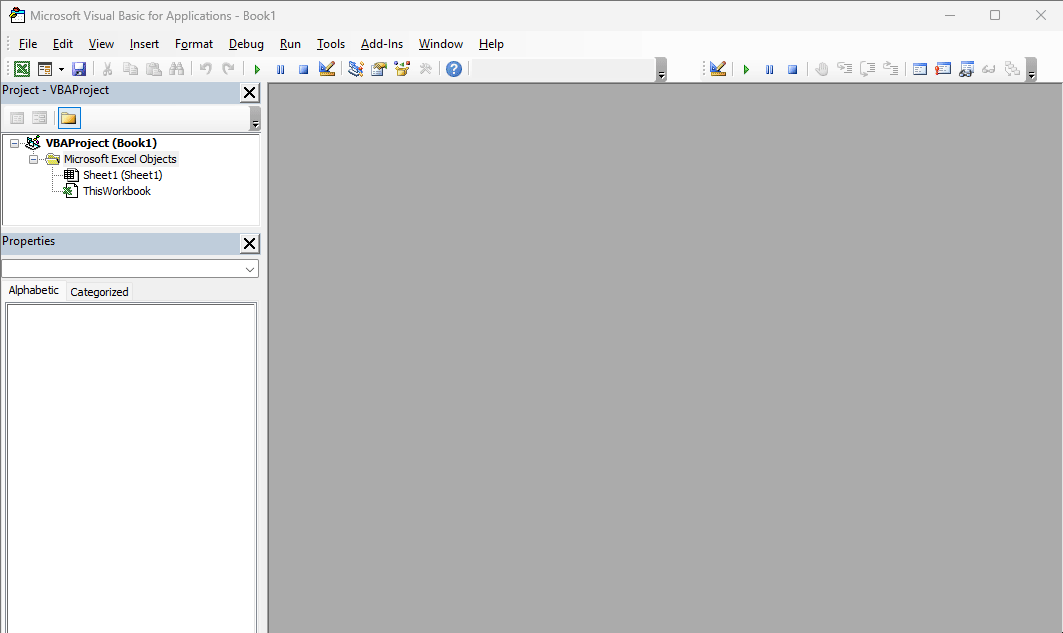
The program consists of:
- Sub Procedure: A Sub procedure called
HelloWorld. Sub procedures are used to define a block of code that performs a specific task such as displaying a message box. TheSubkeyword is followed by the name of the procedure (HelloWorld), and the code block is enclosed inSubandEnd Substatements. - MsgBox Function: Displays a message box with the text “Hello, World!”. Functions in VBA are called using the function name followed by parentheses containing any required arguments. In this case, the
MsgBoxfunction is used to display a message box with the specified text—enclosed in double quotes ("Hello, World!"). TheMsgBoxfuction is a built-in function in VBA (i.e., it is part of the VBA language).
When you save a workbook that contains VBA code, you must save it in the macro-enabled workbook format (.xlsm). This format allows the workbook to contain macros and VBA code. If you save the workbook in a different format (e.g., .xlsx), the VBA code will be removed from the workbook and you will lose your code.
5.5 Configuring the VBA Editor
Before writing VBA code, it’s important to configure the Visual Basic Editor (VBE) to suit your preferences. The VBE provides various options and settings that can be customized to enhance your coding experience.
5.5.1 VBE Window Layout
The VBE window is divided into several panes that help you navigate and edit your VBA code. The main panes in the VBE window are:
Project Explorer: Displays the project structure, including workbooks, modules, and forms. To display the Project Explorer, press
Ctrl + R, or go toView>Project Explorer.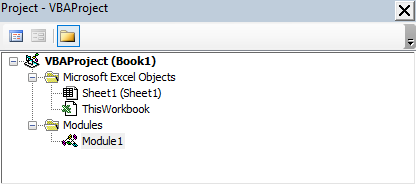
Figure 5.2: The Project Explorer. Code Window: Displays the VBA code for the selected module or form. To display the Code Window, double-click a module or form in the Project Explorer, or press
F7.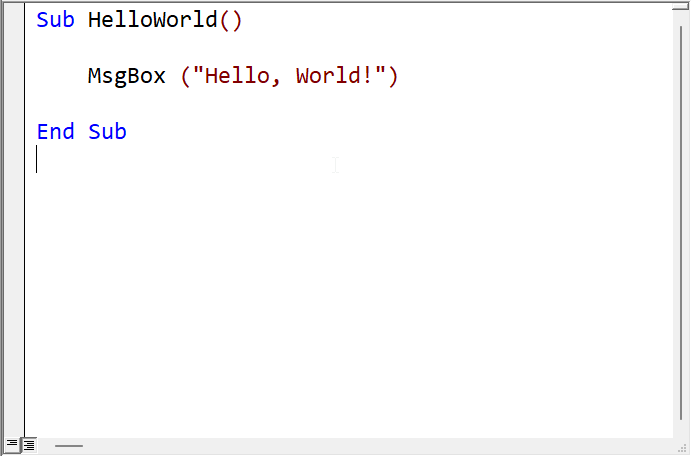
Figure 5.3: The Code Window. Toolbar: Contains buttons for common tasks such as running code, saving files, and editing code. To display the toolbar, right-click the toolbar area and select the desired toolbar.

Figure 5.4: The toolbar. Menu Bar: Contains menus for accessing various VBE commands and options. The menu bar is located at the top of the VBE window.
Additional panes that can be displayed in the VBE window include:
- Immediate Window: Allows you to execute VBA statements interactively. To display the Immediate Window, press
Ctrl + G, or go toView>Immediate Window. - Properties Window: Displays properties for the selected object or control. To display the Properties Window, press
F4, or go toView>Properties Window. - Locals Window: Displays local variables and their values during code execution. To display the Locals Window, press
Ctrl + Shift + L, or go toView>Locals Window.
The Immediate, Properties, and Locals Windows require a more advanced understanding of VBA and will be covered in later chapters.
5.5.2 VBE Edit Toolbar
The Visual Basic Editor (VBE) provides tools to help you edit your code more efficiently. Ensure the Edit toolbar is visible in the VBE. If it’s not, right-click on the toolbar area and select Edit (see Figure 5.6).
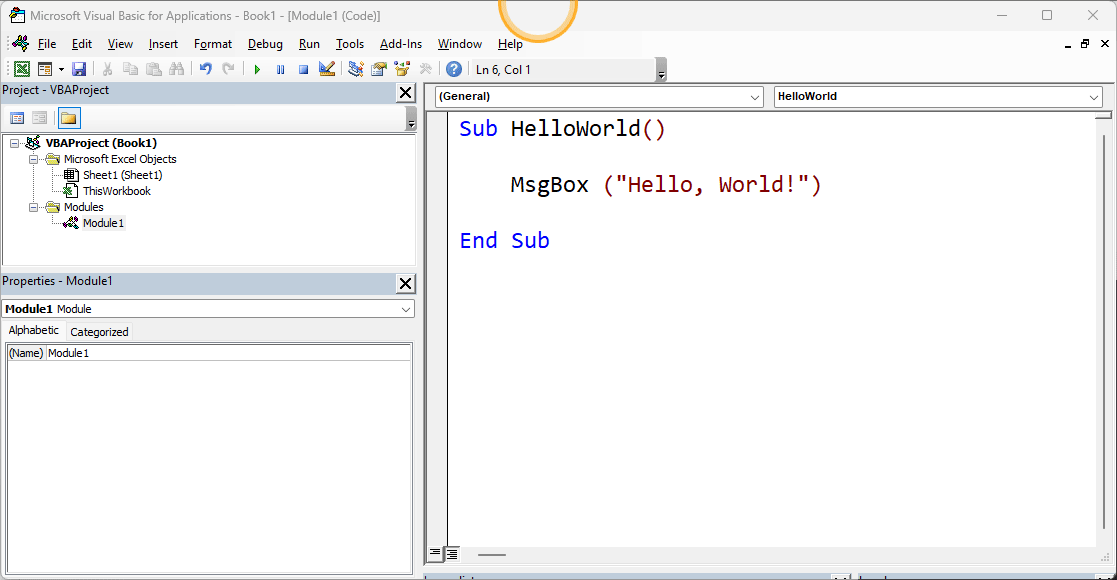
5.5.3 VBE Debug Toolbar
The VBE also includes a Debug toolbar that provides tools for debugging your VBA code. The Debug toolbar contains buttons for running, pausing, and stepping through code to identify and fix issues (see Figure 5.7).
Debugging is the process of identifying and correcting errors in your code to ensure it runs as intended. Debugging will be covered in more detail in later chapters.
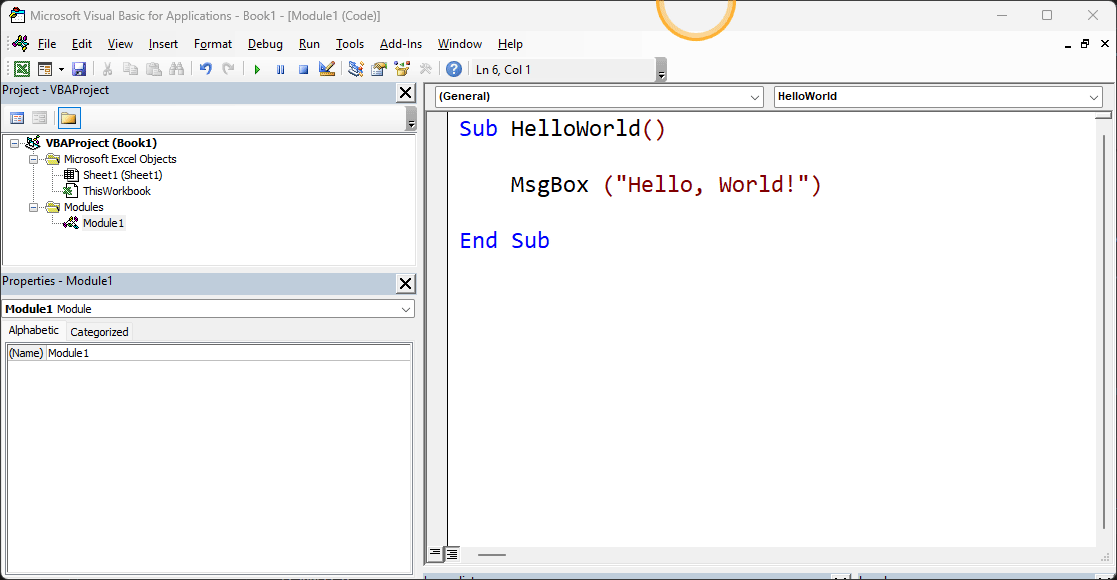
5.7 Conventions for Writing VBA Code
Consistent coding conventions make your code more readable and maintainable. Follow these guidelines when writing VBA code:
- Indentation: Use consistent indentation to make the code structure clear. Tip: Use the
Tabkey to indent code blocks (select multiple lines to indent all at once), and theShift + Tabkeys to unindent. - Naming Conventions: Use meaningful names for variables, functions, and procedures. In VBA, use camelCase for variable names and PascalCase for function and procedure names (e.g.,
myVariable,MyFunction,MyProcedure). For constants, use UPPERCASE_WITH_UNDERSCORES (e.g.,MY_CONSTANT,ANOTHER_CONSTANT). - Modularity: Break down code into smaller, reusable functions and procedures. Refactor code to improve readability and maintainability.
- Lenghth of Lines: Keep lines of code short (around 80 characters) to improve readability. Break long lines into multiple lines if necessary. Use line continuation characters (
_) to split lines.


5.6 Comments
Comments are used to document code and provide explanations for future reference. They are ignored by the compiler and are not executed as part of the program.
5.6.1 Why Use Comments?
Comments are essential for the following reasons:
5.6.2 Syntax
In VBA, comments are indicated by an apostrophe (
') at the beginning of a line or after a statement. Comments can also be added at the end of a line of code. In Listing 5.1, the comments are highlighted in green. Note that, if an apostrophe is used inside quotation marks, it is treated as part of the text and not as a comment.') at the beginning of a line or after a statement. Comments are ignored by the compiler and are not executed as part of the program. Comments can be used to provide explanations, document code, and add context to the codebase.In VBA, the purpose of a Sub or Function is commonly described in a comment above the procedure declaration. For example:
5.6.3 Commenting Guidelines